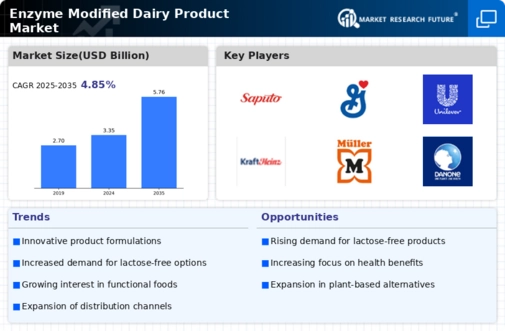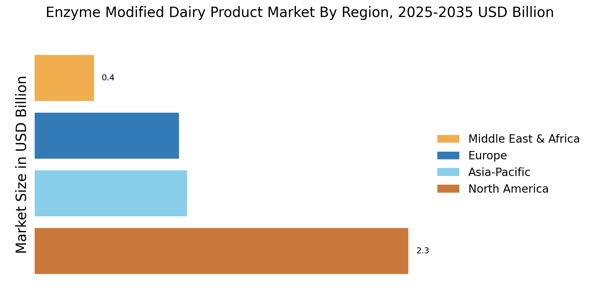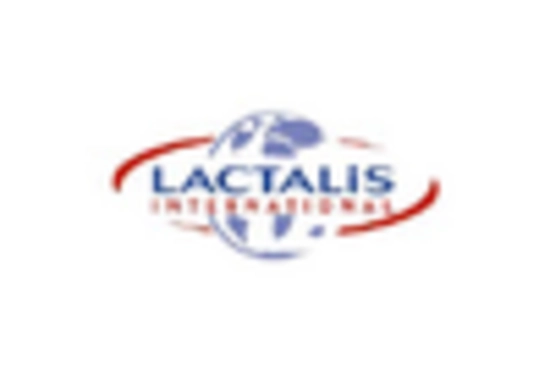Innovative Product Development
Innovation plays a crucial role in the Enzyme Modified Dairy Product Market, as manufacturers continuously seek to develop new and improved products. The integration of enzymes allows for the creation of unique flavors, textures, and functionalities that appeal to diverse consumer preferences. For instance, enzyme-modified cheeses and yogurts are gaining traction due to their enhanced taste profiles and health benefits. Market data indicates that the enzyme-modified cheese segment is expected to witness a growth rate of around 7% annually, reflecting the increasing consumer interest in gourmet and specialty dairy products. This focus on innovation not only attracts health-conscious consumers but also encourages culinary experimentation, further driving the market's expansion.
Health Conscious Consumer Trends
The Enzyme Modified Dairy Product Market is experiencing a notable shift as consumers increasingly prioritize health and wellness. This trend is driven by a growing awareness of the nutritional benefits associated with enzyme-modified dairy products, such as enhanced digestibility and improved nutrient absorption. As a result, the demand for these products is projected to rise, with market analysts estimating a compound annual growth rate of approximately 6% over the next five years. Consumers are actively seeking alternatives that align with their health goals, which is likely to propel the growth of the enzyme modified dairy product sector. Furthermore, the incorporation of enzymes in dairy products can lead to lower lactose levels, catering to lactose-intolerant individuals, thereby expanding the consumer base and driving market expansion.
Rising Demand for Functional Foods
The Enzyme Modified Dairy Product Market is witnessing a surge in demand for functional foods, which are perceived to offer health benefits beyond basic nutrition. Enzyme-modified dairy products, such as probiotic yogurts and fortified cheeses, are increasingly recognized for their potential health advantages, including improved gut health and enhanced immune function. Market Research Future indicates that the functional food sector is expected to grow at a rate of approximately 8% annually, reflecting the rising consumer interest in foods that contribute to overall well-being. This trend is likely to bolster the enzyme modified dairy product market, as consumers actively seek products that align with their health objectives and lifestyle choices.
Sustainability and Environmental Concerns
Sustainability is becoming a pivotal factor in the Enzyme Modified Dairy Product Market, as consumers and manufacturers alike are increasingly concerned about environmental impacts. The use of enzymes in dairy processing can lead to reduced waste and energy consumption, aligning with the growing demand for sustainable food production practices. Reports suggest that enzyme-modified dairy products can lower carbon footprints by optimizing production processes. As consumers gravitate towards brands that demonstrate environmental responsibility, companies that adopt enzyme technology may gain a competitive edge. This trend is likely to influence purchasing decisions, with a significant portion of consumers willing to pay a premium for sustainably produced dairy products, thereby driving market growth.
Technological Advancements in Dairy Processing
Technological advancements are significantly shaping the Enzyme Modified Dairy Product Market, as innovations in dairy processing techniques enhance product quality and efficiency. The application of enzyme technology allows for more precise control over fermentation and aging processes, resulting in superior flavor and texture profiles. Furthermore, advancements in enzyme production and application methods are enabling manufacturers to optimize their processes, leading to cost reductions and improved product consistency. Market analysts project that the adoption of these technologies could lead to a 5% increase in production efficiency within the next few years. As a result, companies that leverage these advancements are likely to gain a competitive advantage, driving growth in the enzyme modified dairy product sector.


















Leave a Comment